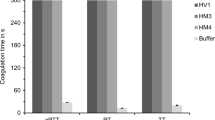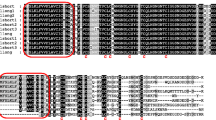Abstract
Biological observations were made on the antihaemostatic activity in the saliva of the giant Amazon leech Haementeria ghilianii. Particular emphasis was placed on determining where the fibrino(geno)lytic enzyme hementin is produced and secreted in the salivary gland complex.
Hungry third-fed Amazon leeches produce about 650 units of hementin, with by far the majority of the activity (75%) in the two posterior glands. The two anterior glands contain much less hementin (12%), and a small amount (12%) resides in the proboscis itself, presumably in the salivary gland ductules. In the anterior gland, hementin appears to be produced by only certain cells. The secretion of hementin is confined to the lumen of the proboscis.
Secretions in the proboscis lumen are rich in antihaemostatic activity, as evidenced by fibrinogenolysis (hementin), prolongation of prothrombin time (PT), activated partial thromboplastin time (APTT), thrombin clotting time (TCT) and Atroxin clotting time, and inhibition of collagen-induced platelet aggregation. In contrast, no anti-haemostatic, including hementin, activity was detectable at the tip. Suprisingly, the wound from the bite by the Amazon leech is not associated with prolonged bleeding. This is in marked contrast to the wound by the European medicinal leech Hirudo medicinalis which bleeds for an average of ten hours. The absence of bleeding is compatible with the interpretation, based on the above findings, that during feeding the Amazon leech does not inject antihaemostatic factors into the host, or at least not in the vicinity of the wound.
Similar content being viewed by others
References
Budzynski AZ, Olexa SA, Brizuela BS, Sawyer RT (1981a) Anticoagulant and fibrinolytic properties from the leech Haementeria ghilianii. Proc Soc Exp Biol Med 168:266–275
Budzynski AZ, Olexa SA, Sawyer RT (1981b) Composition of salivary gland extracts from the leech Haementeria ghilianii. Proc Soc Exp Biol Med 168:259–265
Condra C, Nutt E, Petroski CJ, Simpson E, Friedman PA, Jacobs JW (1989) Isolation and structural characterization of a potent inhibitor of coagulation Factor Xa from the leech Haementeria ghilianii. Thromb Haemost 61:437–441
Jones PG, Sawyer RT, Berry MS (1985) Novel preparation for studying excitation-secretion coupling in the isolated single cell. Nature 315:679–680
Kirschbaum NE, Budzynski AZ (1990) A unique proteolytic fragment of human fibrinogen containing the Aa-COOH-terminal domain of the native molecule. J Biol Chem 265:13669–13676
Malinconico SM, Katz JB, Budzynski AZ (1984a) Hementin: anticoagulant protease from the salivary gland of the leech Haementeria ghilianii. J Lab Clin Med 103:44–58
Malinconico SM, Katz JB, Budzynski AZ (1984b) Fibrinogen degradation by hementin, a fibrinogenolytic anticoagulant from the salivary glands of the leech Haementeria ghilianii. J Lab Clin Med 104:842–854
Munro R, Hechtel FOP, Sawyer RT (1989) Sustained bleeding after a leech bite in the apparent absence of hirudin. Thromb Haemost 61:366–369
Munro R, Powell Jones C, Sawyer RT (1991). Hementin effects on fibrinogen mediated platelets aggregation/deaggregation in vitro. Platelets (in press)
Sawyer RT (1978) Domestication of the world's largest leech for developmental neurobiology. Yearbook of the American Philosophical Society, pp 212–213
Sawyer RT (1986) Leech Biology and Behaviour, Vol. 11. Oxford University Press. Oxford, pp 467–523
Sawyer RT, Lepont F, Stuart DK, Kramer AP (1981) Growth and reproduction of the giant glossiphoniid leech Haementeria ghilianii. Biol Bull 160:322–331
Sawyer RT, Damas D, Tomic M (1982) Anatomy and histology of the salivary gland complex of the giant leech Haementeria ghilianii (Hirudinea: Rhynchobdellida). Arch Zool Exp Gen 122:411–425
Sawyer RT, Powell Jones C, Munro R (1991) The biological function of hementin in the proboscis of the leech Haementeria ghilianii. Blood Coagulation and Fibrinolysis (in press)
Walz B, Schaffner KH, Sawyer RT (1988) Ultrastructure of the anterior salivary gland cells of the giant leech Haementeria ghilianii (Annelids, Hirudinea). J Morphol 196:321–332
Wuttke WA, Sawyer RT, Berry MS (1989) Extraglandular innervation of the salivary cells of the leech Haementeria ghilianii: neuronal stimulation elicits gland-cell action potentials and secretion. J Exp Biol 143:389–410
Author information
Authors and Affiliations
Rights and permissions
About this article
Cite this article
Sawyer, R.T., Casellas, M., Munro, R. et al. Secretion of hementin and other antihaemostatic factors in the salivary gland complex of the giant amazon leech Haementeria ghilianii . Comparative Haematology International 1, 35–41 (1991). https://doi.org/10.1007/BF00422691
Issue Date:
DOI: https://doi.org/10.1007/BF00422691




